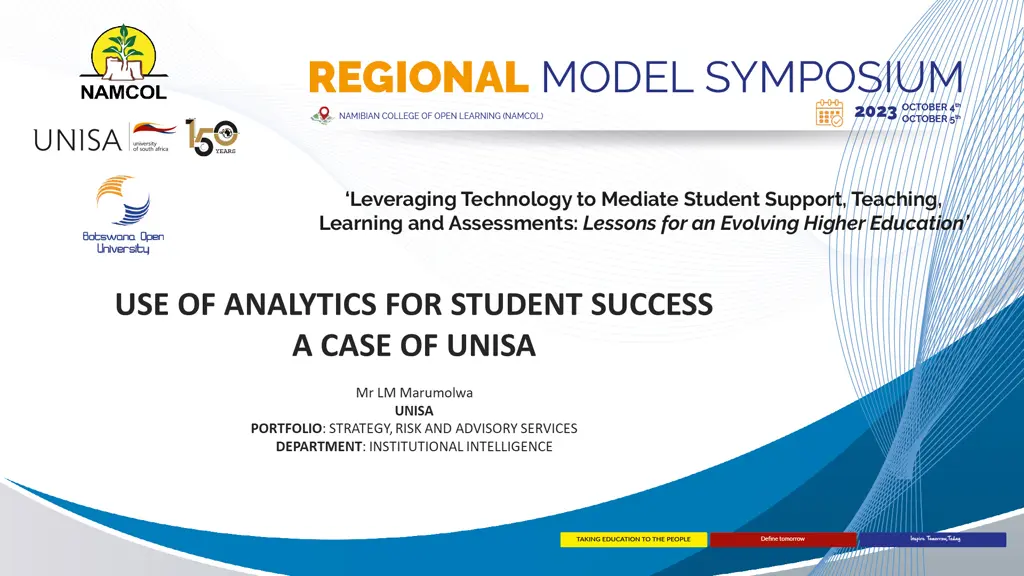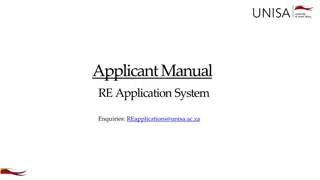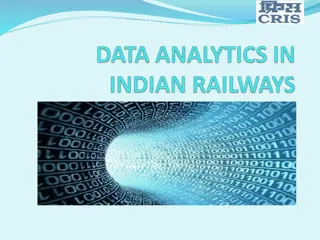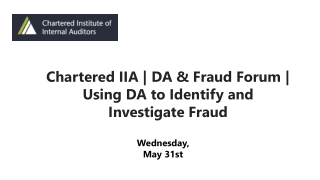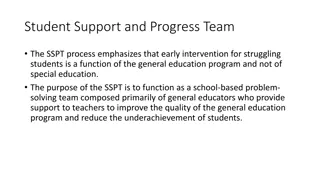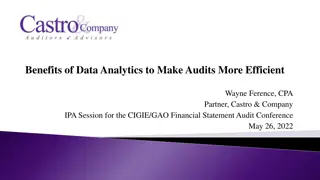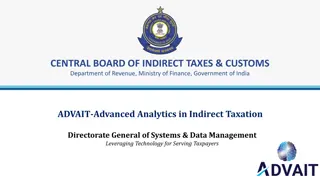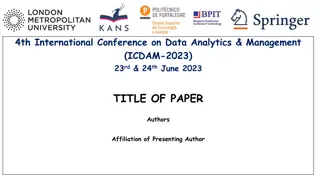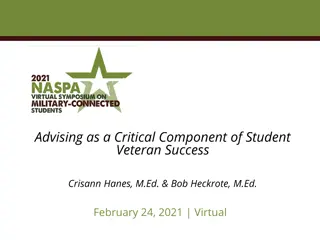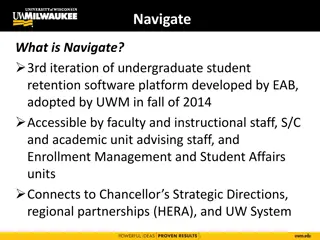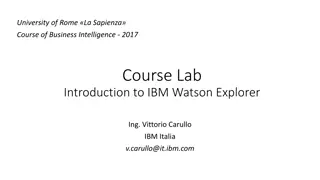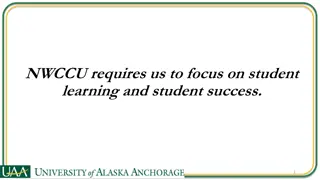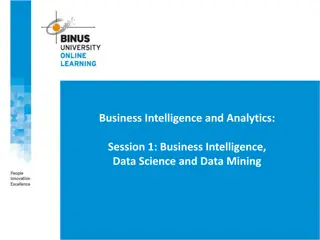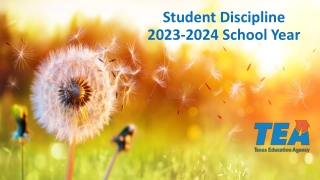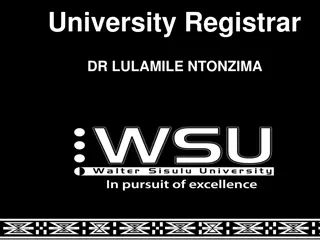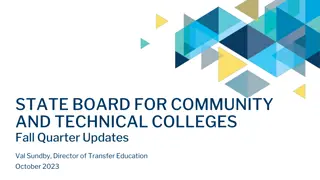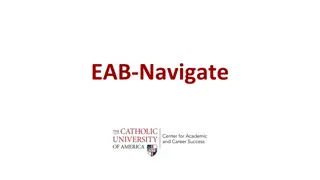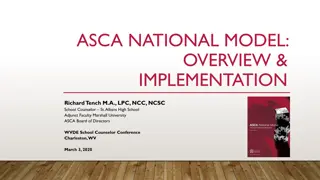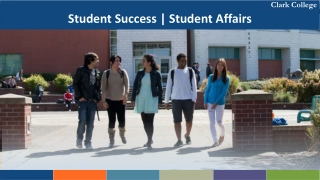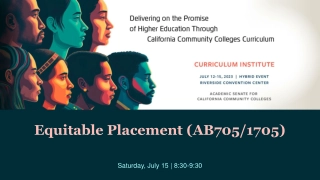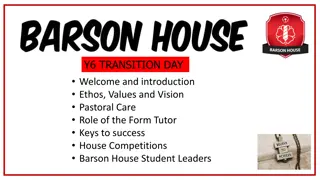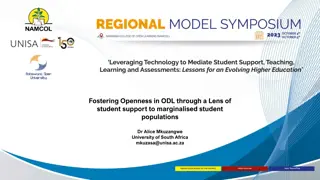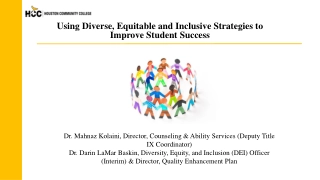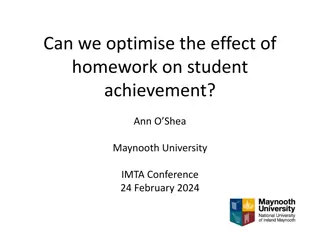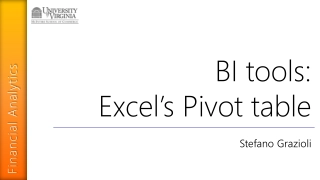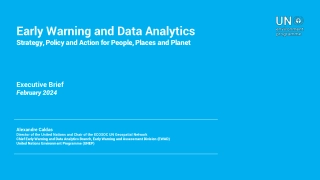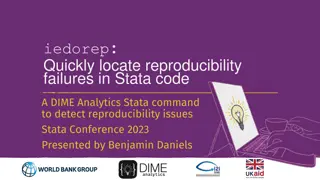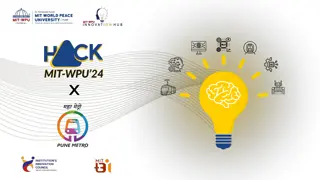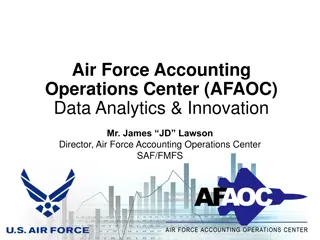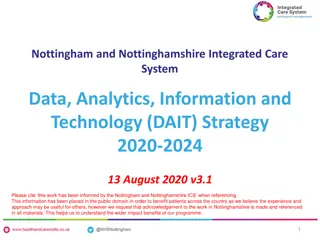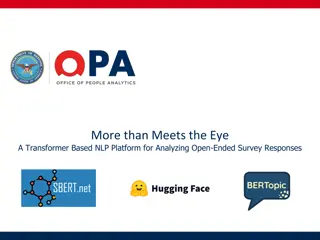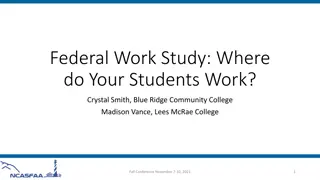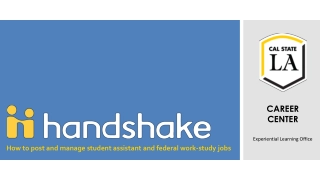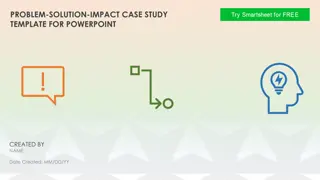Using Analytics for Student Success: A Case Study of UNISA
The implementation and application of analytics for student success at UNISA, focusing on the complexities and modalities involved. It explores the use of analytics to enhance teaching and learning processes, improve academic performance, and provide personalized support to individual learners.
- analytics
- student success
- UNISA
- implementation
- application
- complexities
- modalities
- academic performance
Download Presentation

Please find below an Image/Link to download the presentation.
The content on the website is provided AS IS for your information and personal use only. It may not be sold, licensed, or shared on other websites without obtaining consent from the author. Download presentation by click this link. If you encounter any issues during the download, it is possible that the publisher has removed the file from their server.
E N D
Presentation Transcript
USE OF ANALYTICS FOR STUDENT SUCCESS A CASE OF UNISA Mr LM Marumolwa UNISA PORTFOLIO: STRATEGY, RISK AND ADVISORY SERVICES DEPARTMENT: INSTITUTIONAL INTELLIGENCE
1 INTRODUCTION OVERVIEW COMPLEXITIES OF PRACTISE 2 3 UNISA IMPLEMENTATION 4 OUTPUT 5 ACKNOWLEDGEMENTS
CONTEXT Use of Analytics for Student Success A paradox of an ideal target and vision confused by complexities of practice MODALITIES Modalities of Analytics for Student Success IMPLEMENTATION Implementation of Analytics for Student Success The purpose of this presentation is to share ideas at high-level on how to create an enablement of analytics for student success. APPLICATION Application of Analytics for Student Success ACCESS Access of Analytics for Student Success Assumptions: Existing Knowledge about UNISA Existing Knowledge about Student Success Existing Knowledge about Analytics TECHNOLOGIES Technologies of Analytics for Student Success
MODALITIES OF ANALYTICS FOR STUDENT SUCCESS Focus Application Scope Focus refers to the main point of emphasis or the central theme of a subject, task, or discussion. It directs attention toward a particular aspect or objective. Application implementation of knowledge, techniques, or tools to achieve specific goals or solve real-world problems. involves the practical use or Scope defines the boundaries and extent of a particular topic, project, or area of interest. It outlines what is included and what is excluded in a given context. Learning Analytics Learning analytics is a broad concept that involves analysing data related to various aspects of the learning environment, including learner behaviour, interactions with educational materials, and academic performance. Learning analytics primarily focuses on understanding and improving teaching and learning processes at the institutional or course level. It aims to answer questions about the effectiveness of instructional methods, curriculum design, and overall learning experiences. Learning analytics can inform curriculum design, help educators identify trends in student performance, and support institutional decision-making. It is used to optimize educational practices. Learner Analytics Learner analytics narrows its focus to the individual learner, involving the collection and analysis of data specific to a single student's behaviours, interactions, and academic progress. Academic Performance Analytics Academic performance analytics specifically focuses on data related to students' academic achievements, including grades, test scores, course completion rates, and other performance metrics. Student Cohort Analytics Student cohort analytics involves grouping students into cohorts based on shared characteristics and analysing their collective data over time. Scope Focus Learner analytics is primarily concerned with understanding how an individual student engages with educational resources and materials. It aims to provide insights into a student's learning journey, strengths, weaknesses, and areas where they may need support. Learner analytics is often used to provide personalized support and interventions to individual students. Its goal is to enhance the success and satisfaction of individual learners. The primary focus of academic performance analytics is to assess and improve academic outcomes, including student success, retention, and graduation rates. It aims to understand factors influencing academic performance. The primary focus of student cohort analytics is to gain insights into trends, patterns, and changes within specific student groups. It helps institutions understand the unique challenges and needs of different cohorts. Application Academic performance analytics helps institutions identify at-risk students, evaluate the impact of academic support programs, and make data-driven decisions to enhance overall academic effectiveness. Student cohort analytics informs decisions related to program evaluation, resource allocation, and the development of targeted interventions to support specific groups of students, such as first-year students or students with similar demographics.
IMPLEMENTATION OF ANALYTICS FOR STUDENT SUCCESS The use of data analytics in promoting student success is contingent upon a multitude of drivers and elements that enable the efficient gathering, examination, and utilisation of data to augment students' educational experiences and achievements. Group 3 Group 1 Group 2 Personalized Interventions Data Availability Institutional Culture Technology Infrastructure Continuous Improvement Stakeholder Collaboration Leadership Support Privacy and Compliance Data Integration Analytics Expertise Data Literacy Resource Allocation ANALYTICS MATURITY MODEL Prescriptive Predictive Diagnostic Descriptive How can we make it happen or not happen? If things continue this way what will happen? How and Why it happened? What happened?
APPLICATION OF ANALYTICS FOR STUDENT SUCCESS Intervention Scope Cohort Throughput Operational | Module Design (Pedagogies) | Inform Student Success | Inform Late Cohort Analytics Minimum Time Completion Intervention Qualification Success Cohort Intervention Scope Qualification Academic Performance Intervention Scope Module Success Progression Risk Levels Assessments Results Mid Strategy Intervention Module Exam Attendance Assignment Submissions Learning Analytics Assessment Intervention Scope Learning Units Grade Results Learning Activities Early Learner Analytics Intervention Learning Activities LMS Access
ACCESS OF ANALYTICS FOR STUDENT SUCCESS OPTIONS OF ACCESS OF ANALYTICS FOR STUDENT SUCCESS Office 365 Platform Power BI Service Intranet Data Hub Analytical Data
TECHNOLOGIES OF ANALYTICS FOR STUDENT SUCCESS APPLICATION DATA VISUALIZATION & PRESENTATION DATA ANALYSIS DATABASE MACHINE LEARNING & AI DATA INTEGRATION
UNI-TELLIGENCE ACHITECTURE REFERENCE Data Growth (IoT | M2M | Cloud | Edge Computing) | Big Data | Dark Data
INFORMATION PROUDUCT APPROACH 4 5 6 1 2 Decisions / Actions Source Systems Strategic Objective People Data Sources 3 Business Questions 1. A strategic objective is a clear and concise statement that outlines an organization's long-term goal or desired outcome. It provides a high-level direction for the organization and helps guide its actions and decisions. The process by which leaders and teams choose a course of action from various options to achieve specific objectives. Effective decision-making relies on data, analysis, and sound judgment. Business questions are inquiries that individuals or organizations pose to gain insights, make informed decisions, and drive their operations forward. People in the context of business intelligence and analytics are the driving force behind data-driven decision-making and strategy development within organizations, with their ability to interpret and apply data insights being a key factor in business success. Source systems are critical components of an organization's data infrastructure, serving as the starting point for data processing, analysis, and decision- making. Data sources represent the diverse and valuable origins of data that organizations leverage to gain insights, make informed decisions, and drive their operations forward. 2. 3. 4. 5. 6.
CHANGE MANAGEMENT PLAN ADKAR has be adopted as the Change Management framework to support the impacted and affected stakeholders by creating awareness, developing the required knowledge and ability to implement and support BI & Analytics Awareness Desire Knowledge Ability Reinforcement Reinforcement Reiterate the benefits of the project through communications, events and engagements which showcase and create excitement around the project milestones Post go-live Develop toolkit to support users to sustain the change Awareness Create awareness around BI & Analytics project through targeted and specific communications and engagement to all impacted stakeholder, executives and forums whose support is crucial for the successful delivery of the project Ability Desire Knowledge Unisa on BI & Analytics navigation and functionality to acquire knowledge, skills and behaviours required to effectively deploy BI & Analytics capabilities into the environment Incorporate BI & Analytics demo and show and tell sessions as part of the training to enable users to experience the system live and demonstrate their ability to execute the expected tasks with comfort prior to go- live. Build interest around BI & Analytics through continuous and focused benefits orientated engagements (WITFM) with stakeholders such as leadership.
COLLABORATION PLAN DII Enablement User Competency Outcome Knowledgeable User Advanced User | User Train Other Users | Improve Information Products | Communicate New Updates | Get User Feedback We provide training and support for ad hoc request. We develop user artefacts on advise of these users, that will assist them understand the data structures better. User that has experience and advanced knowledge of deriving insights from Information Products. They are very comfortable with the tools or software and other less familiar users often asks them for assistance. Advanced Users We endorse their information products and provide artefacts that breaks down the semantic model and provide data dictionaries of the data structures that supports semantic model. We work with them to improve and expand our semantic model. We incorporate source data that is critical for their information products. We ensure that their BI applications are authorized to access the required data. Grow the semantic model | Increase Support for Information Products | Continuous Feedback on the Semantic Layer Data Analysts who are proficient with analytical tools and process and are working with data stewards to develop key granular information products for their departments. Super Users We provide comprehensive training on our BI framework and Strategy. We provide them access to deploy and commit code and changes through a governed process. We assist with code reviews and optimizations. Promote workspace to enterprise premium capacity. Implement BI Strategy | Grow the Data Warehouse | Improve Data Engineering Developers who understands the Software Development Lifecycle (SDLC) and highly proficient with applicable systems and software development tools.
ENABLEMENT VEHICLE FOR STUDENT SUCCESS ANALYTICS STUDENTS ACADEMIC PERSISTANCE NEEDS Executives Management Academics Operations Administration Academic Project Unisa Strategy Institutional Planning Digital Transformation Student Walk Research Output Engaged Scholarship Regulations Enterprise Data Warehouse Power BI Report Analytical Database Uni-telligence UI Source Data DIGITAL INFRASTRUCTURE | DATA GOVERNANCE | DATA MANAGEMENT | CLOUD INVESTMENT | DIGITAL SECURITY | 4IR SKIILS Exploiting Existing Reporting & Analytics Investments Embracing Diversity in Reporting Technologies Single Point of Entry for all Analytics & Reporting Integrated Data Service Multi-function analytics on a unified platform eliminate silos and speed the discovery of insights that True support for public cloud, multi- cloud, and deployments hybrid capability with A shared data experience that applies consistent governance, and metadata Better use of the available data and leverage the right data to create competitive advantages security, data-driven on-premises
KEY ENABLEMENT ARCHIEVEMENTS Single Point of Entry Data Insights Culture Over 70 Workspaces Over 350 Reports Multiple Contributors Content Academics Producing Content Onboarding All Organizational Processes
ACKNOWLEDGEMENTS VP VP: : Strategy, Strategy, Risk Prof Prof SK SK Ndlovu Ndlovu Risk and and Advisory Advisory Services Services (Executive Support & Leadership) Executive Executive Director Dr Dr MP MP Molapo Molapo Director: : Institutional Institutional Intelligence Intelligence (Senior Management Support & Leadership) (Capacity and development Support) Directorate Directorate Business Business Intelligence Intelligence (Operational Support) ICT ICT Collaborators Collaborators (Contribution Support)
REFERENCES Guzm n-Valenzuela, C. et al.(2021) Learning analytics in higher education: a preponderance of analytics but very little learning? , International Journal of Educational Technology in Higher Education. doi: 10.1186/s41239-021-00258-x. Han, J. et al.(2021) Learning analytics dashboards for adaptive support in face-to-face collaborative argumentation , Computers and Education, 163. doi: 10.1016/j.compedu.2020.104041. Hasnain, A. et al.(2017) BioFed: Federated query processing over life sciences linked open data , Journal of Biomedical Semantics, 8(1), pp. 1 20. doi: 10.1186/s13326-017- 0118-0. Hern ndez-de-Men ndez, M. et al.(2022) Learning analytics: state of the art , International Journal on Interactive Design and Manufacturing, 16(3). doi: 10.1007/s12008- 022-00930-0. Kahu, E. R. and Nelson, K. (2018) Student engagement in the educational interface: understanding the mechanisms of student success , Higher Education Research and Development, 37(1). doi: 10.1080/07294360.2017.1344197. Khalil, M., Prinsloo, P. and Slade, S. (2022) The use and application of learning theory in learning analytics: a scoping review , Journal of Computing in Higher Education. doi: 10.1007/s12528-022-09340-3. Kleimola, R. and Leppisaari, I. (2022) Learning analytics to develop future competences in higher education: a case study , International Journal of Educational Technology in Higher Education, 19(1). doi: 10.1186/s41239-022-00318-w. Marbouti, F., Ulas, J. and Wang, C. H. (2021) Academic and Demographic Cluster Analysis of Engineering Student Success , IEEE Transactions on Education, 64(3). doi: 10.1109/TE.2020.3036824. Maseleno, A. et al.(2018) Demystifying learning analytics in personalised learnin , International Journal of Engineering and Technology(UAE), 7(3). doi: 10.14419/ijet.v7i3.9789. McIntosh, E. and Nutt, D. (2022) The Impact of the Integrated Practitioner: Perspectives on Integrated Practice to Enhance Student Success* , Student Success, 13(2). doi: 10.5204/ssj.2430. Viberg, O. et al.(2018) The current landscape of learning analytics in higher education , Computers in Human Behavior. doi: 10.1016/j.chb.2018.07.027. van Wyk, M. et al.(2022) The relationship between resilience and student success among a sample of South African engineering students , Cogent Psychology, 9(1). doi: 10.1080/23311908.2022.2057660.
